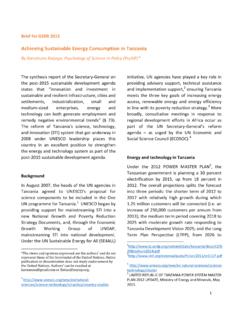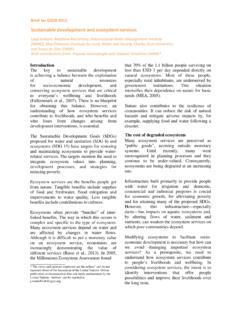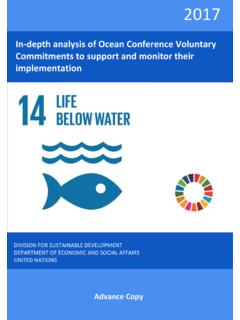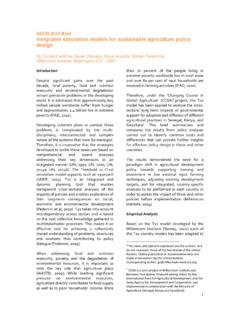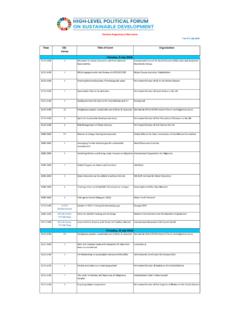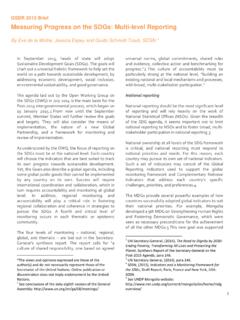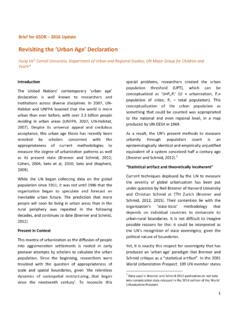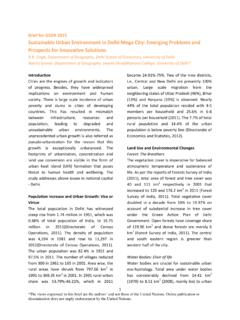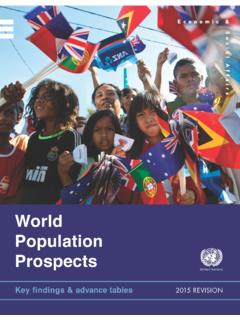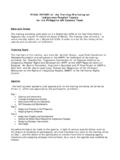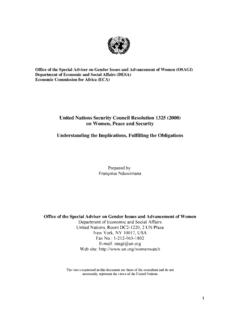Transcription of 74-Mateo-Sagasta-Improving water quality is an …
1 Introduction The Sustainable Development Goal (SDG) targets related to water quality must be ambitious and comprehensive if they are to prevent a global water quality crisis. This is because the scale of water pollution is immense. Every day, humans generate millions of tons of solid and liquid waste. Much of this waste is discharged untreated to water bodies, severely polluting the water and damaging human health, ecosystems and industries. A 2014 analysis supported by the International water Management Institute (IWMI) shows that 24 Mha of irrigated croplands lie within urban areas and 130 Mha of irrigated croplands are located within 20 km of urban areas (Thebo et al., 2014). A significant proportion of this farmland is irrigated with diluted wastewater. In and around 75% of all cities in developing countries, water used for irrigation is highly polluted (Raschid-Sally and Jayakody, 2008).
2 For decades, the fate and impacts of waste and wastewater were poorly considered in the global development agenda spearheaded by the Millennium Development Goals. However, it is now widely recognized that water quality targets need to go beyond access to sanitation facilities. They must address the fate of wastewaters and their impacts on the environment and human health, and be relevant for developed and developing countries alike. Rethinking water quality targets UN- water has proposed water quality targets as part of its recommendations for a dedicated SDG for water . Other groups have advocated for addressing better the water quality challenge, including wastewater management. In developing countries, little if any wastewater and fecal sludge is treated. For example, 92% of _____ * The views and opinions expressed are the authors and do not represent those of the Secretariat of the United Nations.
3 Online publication or dissemination does not imply endorsement by the United Nations. Authors can be reached at the sewage generated in low-income countries, and 72% of that produced in lower middle-income countries is discharged untreated to water bodies. Industry is responsible for dumping an estimated 300 to 400 million tons of heavy metals, solvents, toxic sludge and other waste into our environment. Agrochemicals, sediments from eroded soils and saline drainage water from agricultural activities also end up in water bodies. Standard solutions to control water pollution that work in industrialized countries have not always succeeded elsewhere. Attempts to implement conventional wastewater treatment plants often fail due to poor operation and maintenance, related to limited institutional capacities; unsuitable ( energy-intensive) technology; poor cost-recovery strategies; and people s inability and unwillingness to pay for water services.
4 We need to learn from these shortcomings and set realistic targets for controlling pollution and mitigating impacts that countries can afford to achieve. Supplying and implementing adequate and affordable technologies, however, will be a challenge for the wastewater industry. Globally, estimates of areas irrigated with wastewater vary between 6 and 20 million hectares. Reuse takes place with little or no treatment or other measures to protect health. Aside from direct use, the majority of wastewater is released into the environment and reused indirectly (diluted), mostly unintentionally. Both direct and indirect use of untreated wastewater can pose risks for farmers, food consumers and ecosystems. While, in some regions, the safe and regulated use of wastewater is promoted, informal irrigation with raw or diluted wastewater represents up to 90% of all current wastewater use.
5 The overarching challenge is thus not (only) to support formal reuse but to make ongoing informal practices safe by implementing cost- Brief for GSDR 2015 Improving water quality is an opportunity to avert a global crisis Lead authors: Javier Mateo-Sagasta and Pay Drechsel,(International water Management Institute)* effective health and environmental protection options, including non-treatment methods. Solutions will need to be tailored to the informal sector s contexts and capacities with innovative incentives for performance monitoring. Targets should give countries the flexibility to transition to safe forms of excreta and wastewater management relevant to their situations. For many regions, the cost of building sewage networks and conventional treatment facilities will remain prohibitive, and these regions will need alternative options. On-site sanitation facilities and safe fecal sludge management will probably be the first choice for these countries (Figure 1).
6 Monitoring and evaluating progress of an array of approaches will be a challenge. However, measurable targets that track progress over time can galvanize the sector and catalyze national and donor investment. The successful World Health Organization (WHO)/United Nations Children s Fund (UNICEF) joint monitoring program for water supply and sanitation provides one such example. However, this only considered the household end of the sanitation chain; householders usually have little knowledge of the fate of their wastewater, including fecal matter. Monitoring wastewater progress Although cities and industries produce large amounts of wastewater and sludge, we know little about how much, globally, is produced, collected, treated, used and disposed of. Data reliability decreases once the waste leaves the household especially in developing countries.
7 We know even less about the proportion of valuable resources ( water , organic matter, energy, nitrogen and phosphorus) embedded in these waste streams that is recovered and safely reused for activities such as agriculture. Global organizations, including WHO, UNICEF, the Food and Agriculture Organization of the UN (FAO), the water and Sanitation Program of the World Bank, the International water Management Institute (IWMI), and the UN Environment Programme (UNEP) support global assessments and monitoring initiatives related to waste- water , sanitation and water quality . FAO and IWMI, through AQUASTAT, systematically collect, select and harmonize the best national data on municipal wastewater production, collection, treatment and reuse. However, countries do not use uniform terms to describe wastewater, making it difficult to compare data and to establish a fully homogenous global inventory.
8 Monitoring fecal sludge from onsite facilities such as septic tanks is a challenge that requires significant investment. Data is scarce and unreliable, and there is no global monitoring system. The data on the use of untreated wastes is particularly deficient, due partly to the informal nature of the practice or an unwillingness to disclose data. At regional and global levels, monitoring the state of, and trends in, water quality is a big challenge. UNEP/GEMStat collects surface and groundwater quality data submitted by governments and other organizations. The GEMS/ water Global Network includes more than 4,100 stations, close to million records, and over 100 parameters. Figure 1: Example of re-use oriented fecal sludge management model, as implemented in Ghana. Source: Drechsel et al., 2015 Progress varies between regions; many countries have limited or non-existent water quality monitoring systems, while others lack quality control or need incentives to make their data publicly available.
9 Without sufficient reliable data we cannot: adequately diagnose the health and environmental risks associated with untreated wastewater and sludge; quantify the potential for recovering resources from these wastes; plan solutions; or assess their success. WHO, UN-HABITAT and UNEP are trying to develop a global monitoring mechanism that aligns with the anticipated SDG target and indicators for wastewater and water quality . They will be working with existing monitoring initiatives, as well as investigating new data collection methods, remote sensing and modelling approaches to fill current data gaps. Achieving water quality goals For countries to reach targets related to water quality , they will need to choose institutional and technical solutions that are validated, context-specific and can work at scale. Fortunately, many established, decentralized and low-cost solutions exist, even in the least developed countries (Libhaber and Orozco-Jaramillo, 2013).
10 But as long as lessons from institutional failures are not taken on board the promotion of unsustainable solutions will continue (Murray and Drechsel, 2011). Also positive, is the emerging understanding that economics is as important as technical solutions for scaling up resource recovery and safe reuse (RRR) of wastewater and sludge (Drechsel et al., 2015). IWMI and its partners have also developed scalable RRR business models based on 200 empirical cases that bridge the sanitation and agricultural sectors. The business models are being tested for feasibility in 10 cities across the globe (Otoo and Drechsel, 2015). IWMI and its partners design innovative low-cost technologies that can: work at scale in low-income countries; support livelihoods; enhance food security; support emerging green economies; and contribute to cost recovery in the sanitation service sector.

